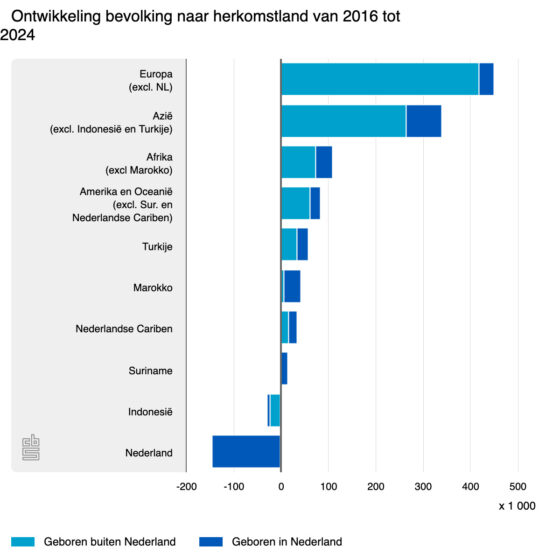The Netherlands’ population hits 18 million, 16% born abroad

The population of the Netherlands is set to reach 18 million people on Thursday, according to estimates by national statistics agency CBS. And with the domestic birth rate shrinking, the growth is entirely down to migration, the agency says.
Follow the countdown in English
The population of the Netherlands hit 17 million eight years ago, but it had taken 15 years to go up from 16 million to 17 million, the CBS said.
Some 16% of the current population were not born in the Netherlands, the biggest group of whom came from another EU country. People from Asia, excluding Indonesia and Turkey, were the next biggest immigrant group.
The expansion of the EU, bringing freedom of movement, the economic situation and English language university and college degrees are behind the growth, as well as wars in Syria and Ukraine, the CBS said.
The date – August 15 – is an estimation and is based on people who are registered with their local authority. This means it does not include the homeless and people who have just arrived.

Although the growth is considerable at 120,000 people a year, between 1945 and 1970 the population grew by 150,000 people a year on average, and that was mainly down to live births. Women in the Netherlands today have an average of 1.43 children which is below the percentage needed to keep the population on an even keel.
The main centres of population growth are in towns around the big Dutch cities such as Rijswijk and Diemen. And the population continues to shrink in the border areas, in southern Limburg, Groningen province and in Zeeland.
The Netherlands is one of the most densely populated countries in the EU, with 518 people per square kilometre. Malta tops the list with almost 1,700 and Belgium is third with 384.
Tough policies
The new right-wing government in the Netherlands has said it will impose “the toughest regime for admitting refugees and the broadest package to get a grip on migration ever”. But many of their suggestions so far conflict with current laws and treaties.
Economists and statisticians have also warned that the Netherlands will need to bring more foreign workers into the country to cope with having an aging population and to plug workforce gaps.
Some three million extra immigrants would be needed to shore up the workforce and pay taxes by 2040, the government’s independent advisory body on migration, the Adviesraad Migratie said in December. But given that is not a realistic option, people already here will have to work more hours or retire later instead, the council said.
Others have suggested a rethink of the current economic focus on industrial farming and logistics, which require large amounts of cheap, foreign labour.
Thank you for donating to DutchNews.nl.
We could not provide the Dutch News service, and keep it free of charge, without the generous support of our readers. Your donations allow us to report on issues you tell us matter, and provide you with a summary of the most important Dutch news each day.
Make a donation